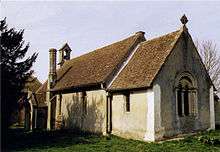Catmore
| Catmore | |
 A valley below Catmore |
|
 Catmore |
|
| Population | 28 (2001) |
|---|---|
| OS grid reference | SU4580 |
| Civil parish | Catmore |
| Unitary authority | West Berkshire |
| Ceremonial county | Berkshire |
| Region | South East |
| Country | England |
| Sovereign state | United Kingdom |
| Post town | Newbury |
| Postcode district | RG20 |
| Dialling code | 01488 |
| Police | Thames Valley |
| Fire | Royal Berkshire |
| Ambulance | South Central |
| EU Parliament | South East England |
| UK Parliament | Newbury |
Coordinates: 51°31′08″N 1°20′53″W / 51.519°N 1.348°W

Catmore is a civil parish and small village in West Berkshire about 5.5 miles (8.9 km) south-east of Wantage. Catmore is in the Berkshire Downs and the centre of the village is about 575 feet (175 m) above sea level. The 2001 census recorded a population of only 28, making Catmore the least populous parish in Berkshire.[1] At the 2011 Census the population was included in the civil parish of Farnborough.
Toponym
In the 11th century the village was recorded as Catmere.[2] The toponym evolved via "Catmor" in the 12th century, "Cattermere" in the 14th century, "Catmard" in the 15th century and "Cattmere" in the 17th century before reaching its present form.[2]
Manor
The earliest known record of Catmore is from the time of Edward the Confessor (reigned 1042–66), when a Saxon called Ezui held the manor.[2] The manor was devastated in the Norman Conquest of England.[2]
The Domesday Book of 1086 records that what was left of the manor was held by the Norman baron Henry de Ferrers.[2] Under the de Ferrers, Catmore became part of the Honour of Tutbury. Two centuries later Robert de Ferrers, 6th Earl of Derby took part in a rebellion against Edward III.[2] He was defeated at Chesterfield in 1266, imprisoned, and all his properties were confiscated by the Crown.
In 1267 Edward III created Edmund Crouchback 1st Earl of Lancaster and granted him many of the de Ferrers estates, including those of the Honour of Tutbury.[2] In 1399 Henry Bolingbroke, 2nd Duke of Lancaster became Henry IV and the House of Lancaster's estates were merged with those of the Crown.[2]
Catmore manor house was built in the 16th century.[2]
Parish church
The Church of England parish church of Saint Margaret is a Norman building[3] from the latter half of the 12th century.[2] Surviving original Norman work includes the north and south doorways and the font.[3] The north doorway is now blocked and the font has been halved in height.[2]
The Knights Hospitaller held the advowson of St. Margaret's by the time of Richard I (reigned 1189–99).[2] They retained it until Henry VIII had the Order in England suppressed as part of the Dissolution of the Monasteries.[2]
The nave was re-roofed in 1607.[2][3] It has collar beams and wind braces and the date is carved on some of its timbers.[2][3]
By 1850 the building had been heavily restored and numerous more Norman Revival features more ornate than the original work had been added.[3] These include the east window of two round-headed lancets.[2] Neither the date of the work nor the name of the architect is recorded.
St. Margaret's has one bell, cast by Henry Bagley.[2] The Bagley family ran a bell foundry at Chacombe in Northamptonshire from 1605 until 1785, and for shorter periods also cast bells at Ecton in Northamptonshire and Witney in Oxfordshire.
The church was designated as a Grade I listed building on 24 November 1966.[4] It was declared redundant on 1 December 1973, and vested in the Churches Conservation Trust on 13 April 1999.[5] It is open daily to visitors.[6]
References
- ↑ "West Berkshire (Unitary Authority)". Neighbourhood Statistics: Full Dataset View. Office for National Statistics. Retrieved 20 July 2010.
- 1 2 3 4 5 6 7 8 9 10 11 12 13 14 15 16 17 Page & Ditchfield, 1924, pages 9–11
- 1 2 3 4 5 Pevsner, 1966, page 110
- ↑ Historic England, "Church of St Margaret, Catmore (1210997)", National Heritage List for England, retrieved 28 January 2014
- ↑ Diocese of Oxford: All Schemes (PDF), Church Commissioners/Statistics, Church of England, 2011, p. 2, retrieved 30 March 2011
- ↑ St Margaret's Church, Catmore, Berkshire, Churches Conservation Trust, retrieved 30 March 2011
Sources
- Page, William; Ditchfield, P.H., eds. (1924). Victoria County History: A History of the County of Berkshire, Volume 4. pp. 9–11.
- Pevsner, Nikolaus (1966). The Buildings of England: Berkshire. Harmondsworth: Penguin Books. p. 110.
External links
![]() Media related to Catmore at Wikimedia Commons
Media related to Catmore at Wikimedia Commons